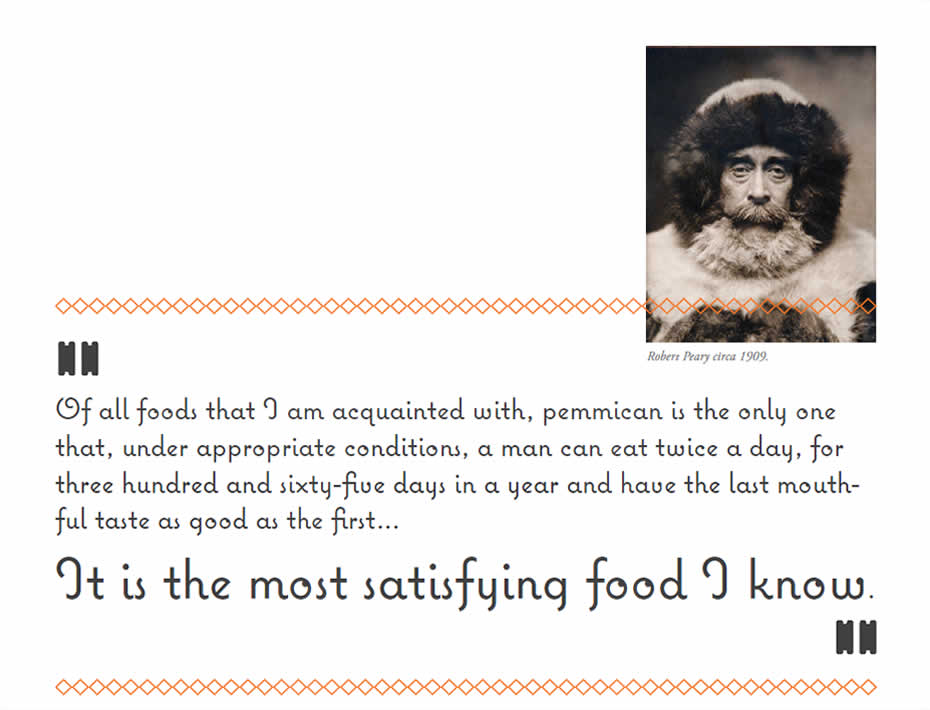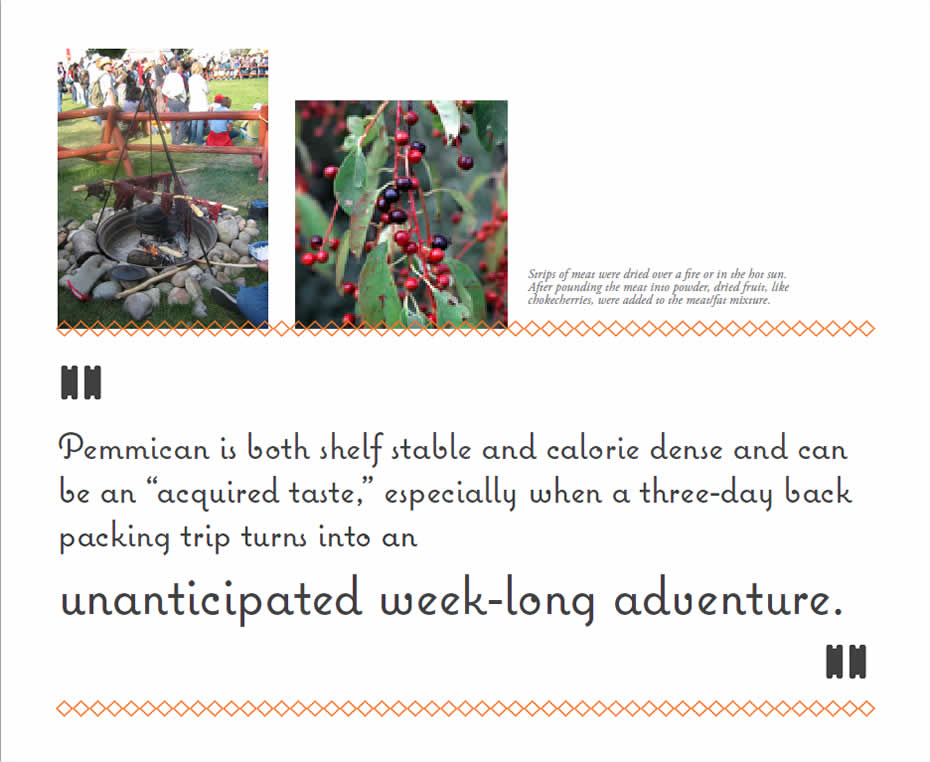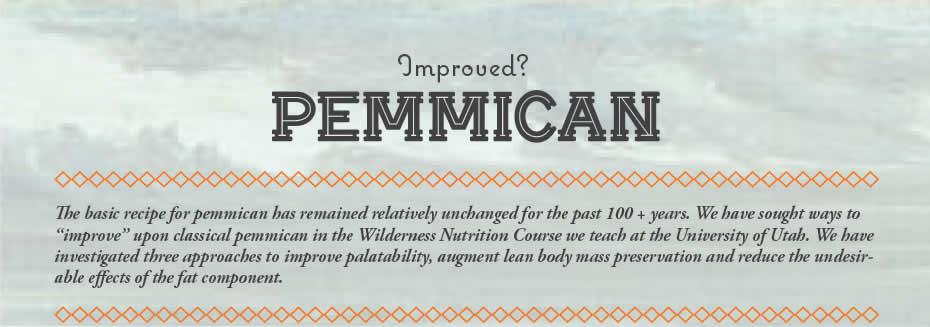Pemmican is a concentrated mixture of dried ground meat, berries and fat, believed to have been developed by the na- tive peoples of North America. Traditionally, pemmican was prepared by drying strips of the flesh of large game animals such as deer, elk or bison over a slow fire in the hot sun until it was hard and brittle. It was pounded into powder using stones. Dried Saskatoon berries, cranberries, blueberries or choke cherries were added to the meat and fat mixture.
Pemmican has long been a staple of explorers and adventur- ers needing to pack as many shelf-stable calories as possible for long periods with no resupply. The berries provided some vitamin C, the meat provided an excellent source of protein, and the tallow provided calories and fat-soluble vitamins. The heavy coating of fat coupled with the low water activity of the mixture minimized oxygen exposure forestalling rot- ting and discouraging microbial growth.
Pemmican was a staple on early Arctic explorations and used by such renowned explorers as Peary, Scott, Shackleton, Ste- fansson and Lewis and Clark. Early Arctic explorers were great proponents of pemmican, as noted by Robert Peary in this observation from his 1917 book Trace that may have permitted pemmican eaterhe Secrets of Polar Travels: “Of all the items which go to make up the list of supplies for a polar expedition, the one which ranks first in importance is pemmican…. With pemmican, the most serious sledge-journey can be undertaken and carried to a successful issue in the absence of all other foods.”

Peary and his men ate their pemmican cold – one-half pound twice a day. He wrote: “Of all foods that I am acquainted with, pemmican is the only one that, under appropriate conditions, a man can eat twice a day, for three hundred and sixty-five days in a year and have the last mouthful taste as good as the first... It is the most satisfying food I know.” Other than pemmican, Peary carried only tea, condensed milk and hardtack – a diet that most modern day backpackers would not find “hedonically rewarding.”
Modern palates notwithstanding, Minnesotan Will Steger relied upon a version of pemmican to support his 1986 dog- sled journey Arctic expedition to retrace Peary’s route to the North Pole. In his 1987 book North to the Pole Will Steger, along with Paul Schurke, characterized the pemmican used as “60% ground beef, 40% fat and small amounts of wheat germ, molasses and rose hips.” They supplemented their 8 ounces of pemmican per day with rolled oats, peanut butter, butter, egg noodles and cheese.
Pemmican is still a backpacker’s food staple over 100 years after Perry subsisted upon it in his search for the North Pole. Nowadays most people assiduously trim the fat off their steak and purchase the leanest ground beef at the supermar- ket. Unaccustomed to pemmican, they would abhor the thought of eating a mixture of 50/50 fat and dried meat. Considering the epidemiological link between cardiovascu- lar disease, saturated fat and red meat consumption, pemmi- can is guaranteed to awaken the latent nutritional messages and concerns to reduce our consumption of fat. Why then, didn’t all these old time pemmican advocates drop dead at an early age? Well, much like our cardiovascular current mortality rates, disease susceptibility probably depended to a significant degree upon their genetics; some of them did die relatively young (Shackleton died at age 48, Peary at age 64), but others lived to a ripe old age (Stefansson died at age 83).

The saving grace that may have permitted pemmican eaters to escape early death from cardiovascular disease was probably two fold. First, when they were eating pemmican, they were also working at high rates of energy expenditures, likely burning off much of the harmful saturated fat before it had a chance to build up in their arteries. Second, pem- mican was often only a portion of the daily food intake and not usually consumed habitually for extended periods. The monotony of the pemmican diet certainly must have been a strong incentive to encourage people to seek other foods to supplement their daily diet. But at the end of a long hard, cold day on the trail, it must have been comforting to know that filling food was at hand that would not require any ex- tensive preparation before turning in for the night.
Despite its high fat content, classical pemmican may still have some utility to the modern day backpacker. Food per- ishability and weight are still the same concerns today as they were at the turn of the century. Pemmican is both shelf stable and calorie dense and can be an “acquired taste,” espe- cially when a three-day back packing trip turns into an un- anticipated week-long adventure. Pemmican is an excellent emergency backup food. Pemmican also is a handy food for easy preparation at the end of a long day on the trail when the camper is overtaken by darkness and bad weather. Stir- ring in a few ounces of pemmican to some hot water can make a hot, nourishing and appetite-satisfying soup.
You don’t want to survive on pemmican alone. Strenuous backpacking will lead to daily glycogen depletion, best re- plenished with carbohydrates. For low to moderate exertion of long duration, diets high in fat work relatively well, but require a prior period of adaptation.

PEANUT BUTTER
Improves Palatability
Substitute peanut butter for the fat component and it is al- most universally acceptable. The disadvantage, compared to lard, a reduction in caloric density and a reduction in the shelf life.
LEUCINE
Improves Metabolic Support of Lean Body Mass
Pemmican is often utilized in situations when food may be scarce or when physical exertion may exceed caloric intake. To help maintain lean body mass during periods of caloric deprivation, we add the branch chain amino acid leucine to minimize muscle tissue loss at the expense of fat loss (Balange and Dardevet 2010). 1 Leucine-containing whey protein powder does not negatively alter the taste and makes achieving the dose of 3 g of leucine per 1000 kcal of pem- mican feasible. It is conceivable, based upon the weight loss literature, that supplemented pemmican may aid in main- taining critical muscle mass in backpacking trips when en- ergy expenditure outpaces energy intake.
SPICE
Offsets the Undesirable Effects of a High Fat Diet
The saturated fat content of pemmican and high fat diets in general have always been a concern to nutritionists. This problem has been addressed by Skulas-Ray et al,2 who added a mixture of 14 g of common cooking spice extracts to meals containing 37% fat. They subsequently measured the short term blood lipid and oxidative stress responses and found that the incorporation of the spices into a high fat meal helped normalize blood triglyceride levels and enhanced antioxidant defenses. The bolstering of the antioxidant de- fenses reduced the peroxidation of LDL resulting from the high fat meal. (Peroxidized LDL particles are believed to be incorporated in plaque at a more rapid rate than normal unoxidized LDLs). We incorporated this spice mixture of black pepper, cinnamon, cloves, garlic, ginger, oregano, pa- prika, rosemary and turmeric into our classical pemmican recipe. The transformation was remarkable: what was previ- ously a bland, greasy product was a “zingy” greasy product. Our students all preferred the spiced pemmican. Whether or not the spice mixture will have the same beneficial tri- glyceride lowering effect in response to a pemmican meal re- mains to be established, but, by extrapolation, the approach appears promising.

A good internet source of information on pemmican preparation by Lex Rooker can be found at traditionaltx.us/images/PEMMICAN.pdf
If there are other pemmican devotees with recipes, drop a line with your suggestion to [email protected]
1. Balage M and Dardevet D. Long term effects of leucine supplementation on body composition. Current Opinion in Clin Nutr and Metab Care. 2010; 13:265-270. 2. Skulas-Ray AC et al. A high antioxidant spice blend attenuates postprandial insulin and triglyceride responses and increases some plasma measures of antioxidant activity in healthy overweight men. J Nutr. 2011; 141:1451-1457.